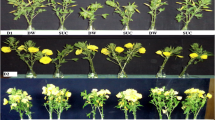Abstract
Seedlings of C. rubrum were irradiated with different light qualities and intensities following a single inductive dark period. Our results show that relatively low intensity white light (35–100 ft. c.) does not support flower development while high intensity white light (650–800 ft. c.) permits 100% flowering. We have shown that the low intensity light inhibiton of flower development is not due to suboptimal photosynthesis. Relatively low intensities of light rich in far-red or blue wavebands sustains optimum flower development, whereas red light is totally ineffective in this respect. Considering that the intensity dependent High Energy Reaction (HER) has its action maxima in the blue and far-red we propose that HER may be positively involved in the flower development of C. rubrum. Our study further suggests that there may be some flower inhibitory component at play in relatively low intensity white light conditions and HER may be required to counteract this flower inhibitory effect.
Similar content being viewed by others
Abbreviations
- SD:
-
short day plant
- HER:
-
High Energy Reaction
- PFR :
-
far-red absorbing form of phytochrome
- PR :
-
red absorbing form of phytochrome
- L.I.I.:
-
low intensity incandescent white light
- H.I.I.:
-
high intensity incandescent white light
- L.I.F.:
-
low intensity fluorescent white light
- H.I.F.:
-
high intensity fluorescent white light
- GA3 :
-
gibbrellic acid
References
Andreae, S., Hopkins, W.G.: Interaction of abscicic acid and red light during induction of flowering of Chenopodium rubrum. Plant Physiol. 51, Suppl. 158, 29 (1973)
Borthwick, H.A., Hendricks, S.B., Schneider, M.J., Taylorson, H.B., Toole, B.K.: The high energy light action controlling plant responses and development. Proc. nat. Acad. Sci. (Wash.) 64, 479–486 (1969)
Butler, W.L., Hendricks, S.B., Siegelman, H.W.: Action spectra of phytochrome in vitro. Photochem. Photobiol. 3, 521–528 (1964)
Carr, D.J.: On the nature of photoperiodic induction IV. Preliminary experiments on the effect of light following the inductive long dark period in Xanthium pennsylvanicum. Physiol. Plant. 10, 249–265 (1957)
Cumming, B.G.: Photoperiodism and rhythmic flower induction: complete substitution of inductive darkness by light. Canad. J. Bot. 47, 1241–1250 (1969)
Emerson, R.: The quantum yield of photosynthesis. Ann. Rev. Plant Physiol. 9, 1–24 (1958)
Evans, L.T., Hendricks, S.B., Borthwick, H.A.: The role of light in suppressing hypocotyl elongation in lettuce and petunia. Planta 64, 201–218 (1965)
Hamner, K.C.: Interrelation of light and darkness in photoperiodic induction. Bot. Gaz. 101, 658–687 (1940)
Hillman, W.S.: Red light, blue light and copper ion in the photoperiod control of flowering in Lemna perpusilla 6746. Plant and Cell Physiol. 6, 499–506 (1965)
Hoshizaki, T., Hamner, K.C.: Interactions in plant photoperiodism. Photochem. Photobiol. 10, 87–96 (1969)
Mukherjee, I.: Effect of sucrose and gibberellic acid on floral induction of Xanthium. Physiol. Plant. 22, 694–700 (1969)
Sawhney, R.: Nature of light requirement for the flowering of Chenopodium rubrum L. (ecotype 60° 47′ N) I. Pre-induction light period. Planta 133, 97–102 (1977)
Sawhney, R., Cumming, B.G.: Non-photosynthetic light requirment for the development of flowers in Chenopodium rubrum, a short-day plant. Canad. J. Bot. 53, 512–516 (1975)
Schuster, M., Kandeler, R.: The significance of photosynthesis for long-day flowering of the short-day plant Lemna perpusilla 6746. Z. Pflanzenphysiol. 63, 308–313 (1970)
Schwabe, W.W.: Factors controlling flowering in the Chrysanthemum. II. Day length effects on the further development of influorescence buds and their experimental reversal and modification. J. expt. Biol. 2, 223–237 (1951)
Searle, N.E.: Persistence and transport of flowering stimulus in Xanthium. Plant Physiol. 36, 656–662 (1961)
Zeeuw, D. de: De invloed van het blad op de bloei. Meded Landbouwhogeschool, Wageningen 54, 1 (1954)
Author information
Authors and Affiliations
Additional information
This paper constitutes a part of a Ph.D. thesis submitted to the University of Western Ontario, London, Ontario.
Rights and permissions
About this article
Cite this article
Sawhney, R. Nature of light requirement for the flowering of Chenopodium rubrum L. (Ecotype 60° 47′ N). Planta 133, 103–106 (1977). https://doi.org/10.1007/BF00391905
Received:
Accepted:
Issue Date:
DOI: https://doi.org/10.1007/BF00391905



